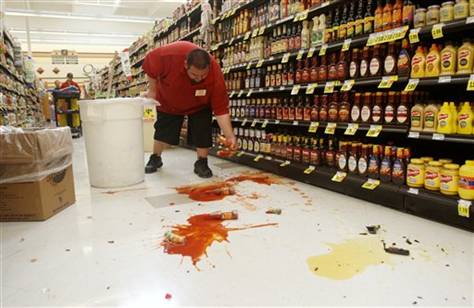 A moderate earthquake jolted Southern California on Wednesday, rattling buildings in downtown Los Angeles, toppling wine bottles at desert resorts and briefly halting rides at Disneyland.
A moderate earthquake jolted Southern California on Wednesday, rattling buildings in downtown Los Angeles, toppling wine bottles at desert resorts and briefly halting rides at Disneyland. A moderate earthquake jolted Southern California on Wednesday, rattling buildings in downtown Los Angeles, toppling wine bottles at desert resorts and briefly halting rides at Disneyland.
A moderate earthquake jolted Southern California on Wednesday, rattling buildings in downtown Los Angeles, toppling wine bottles at desert resorts and briefly halting rides at Disneyland.
There were no immediate reports of injuries or major damage, although residents across a wide swath of Southern California were spooked by the force of the magnitude-5.4 quake.
It struck at 4:53 p.m. and was centered 28 miles south of Palm Springs, or about 130 miles east of Los Angeles, the U.S. Geological Survey said. Dozens of aftershocks have been recorded, with the largest measuring magnitude-3.0.
Laura Anderson, a manager at The Palms at Indian Head Hotel, said she ran outside when the shaking started and was surprised to learn the temblor's magnitude wasn't higher.
"It was quite a shaker," she said. "It was enough to knock over some wine bottles and some pictures fell off the wall.
The quake was initially reported as a magnitude-5.9 but was later downgraded to 5.4. Sheriff's departments in Los Angeles, Riverside, Orange and San Diego counties had no immediate reports of major damage or injuries.
Police Lt. John Booth said there were no reports of serious damage or injuries in Palm Springs, a desert city of about 43,000, but the phone was ringing off the hook and many residents were shaken up.
The earthquake had no effect on the Palm Springs Tramway, which takes tourists and hikers to the top of Mt. San Jacinto. But the seismic action triggered a rock slide on a nearby ridge, tramway spokeswoman Lena Zimmerschied said.
Disneyland spokeswoman Suzi Brown said all rides were being inspected before guests would be allowed back on, in line with resort policy after any seismic activity, she said.
"The rides come back on as they're inspected, so some within a matter of minutes, some a little longer depending on the attraction," she said.
Caltech seismic analyst Anthony Guarino said preliminary information indicates the quake was on the San Jacinto fault, one of two that were stressed by the 7.2-magnitude temblor near the U.S.-Mexico border on Easter.
Wednesday's quake was related to the powerful Easter Day temblor, but it was not an aftershock. Seismologist Kate Hutton of the California Institute of Technology said strain from the April temblor transferred to a different fault zone and triggered Wednesday's quake.
Recent airborne analysis by the NASA Jet Propulsion Laboratory found that the Easter quake put increased pressure on the San Jacinto Fault and neighboring Elsinore Fault.
"There's certainly a little higher level of activity than we've seen before" along the two faults, said JPL geophysicist Eric Fielding.
The upshot is that the Easter quake appeared to have decreased the stress on the southernmost San Andreas Fault — slightly lowering the chance of a quake on the mother of California faults.
That's "good news for us living in Southern California," Fielding said.